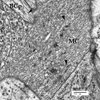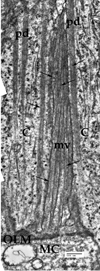Foveolar Müller Cells of the Pied Flycatcher: Morphology and Distribution of Intermediate Filaments Regarding Cell Transparency
- PMID: 26926795
- PMCID: PMC4940978
- DOI: 10.1017/S1431927616000507
Foveolar Müller Cells of the Pied Flycatcher: Morphology and Distribution of Intermediate Filaments Regarding Cell Transparency
Abstract
Specialized intermediate filaments (IFs) have critical importance for the clearness and uncommon transparency of vertebrate lens fiber cells, although the physical mechanisms involved are poorly understood. Recently, an unusual low-scattering light transport was also described in retinal Müller cells. Exploring the function of IFs in Müller cells, we have studied the morphology and distribution pattern of IFs and other cytoskeletal filaments inside the Müller cell main processes in the foveolar part of the avian (pied flycatcher) retina. We found that some IFs surrounded by globular nanoparticles (that we suggest are crystallines) are present in almost every part of the Müller cells that span the retina, including the microvilli. Unlike IFs implicated in the mechanical architecture of the cell, these IFs are not connected to any specific cellular membranes. Instead, they are organized into bundles, passing inside the cell from the endfeet to the photoreceptor, following the geometry of the processes, and repeatedly circumventing numerous obstacles. We believe that the presently reported data effectively confirm that the model of nanooptical channels built of the IFs may provide a viable explanation of Müller cell transparency.
Keywords: IFs; Müller cells; avian retina; transparency.
Figures









References
-
- Alizadeh A, Clark JI, Seeberger T, Hess J, Blankenship T, Spicer A, FitzGerald PG. Targeted genomic deletion of the lens-specific intermediate filament protein CP49. Invest Ophthalmol Vis Sci. 2002 Dec;43(12):3722–3727. - PubMed
-
- Alizadeh A, Clark J, Seeberger T, Hess J, Blankenship T, FitzGerald PG. Targeted deletion of the lens fiber cell-specific intermediate filament protein filensin. Invest Ophthalmol Vis Sci. 2003;44:5252–5258. - PubMed
-
- Alizadeh A, Clark J, Seeberger T, Hess J, Blankenship T, FitzGerald PG. Characterization of a mutation in the lens-specific CP49 in the 129 strain of mouse. Invest Ophthalmol Vis Sci. 2004 Mar;45(3):884–891. - PubMed
-
- Benedek GB. Theory of transparency of the eye. Appl Optics. 1971;10:459–471. - PubMed
Publication types
MeSH terms
Grants and funding
LinkOut - more resources
Full Text Sources
Other Literature Sources

